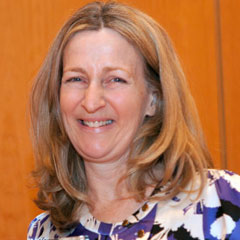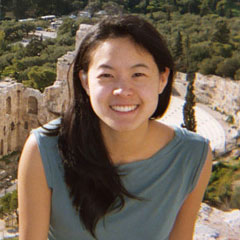New Writer Laurel Croza
 I’ve been asked to talk a little bit about the writing process, about how this book, I Know Here, came to be written. I’ll start by saying: I’m not a writer who wrote—toiling and struggling, in my unheated attic—for 20 years before, finally, getting my story published.
I’ve been asked to talk a little bit about the writing process, about how this book, I Know Here, came to be written. I’ll start by saying: I’m not a writer who wrote—toiling and struggling, in my unheated attic—for 20 years before, finally, getting my story published.
No.
I was a dreamer who dreamed—for 20 years in my heated house— of becoming a writer. It was fun – absolutely no toil and struggle involved—and it was easy. Best of all, it was safe.
But then one morning I woke up and understood that safe was no longer an option. In 2002—about a month after I’d had surgery for lung cancer—my husband and I met with an oncologist to discuss further treatment. The doctor told us that there really weren’t any options available. He said that successful surgery, like mine, was about as hopeful as hopeful gets with lung cancer. As we were leaving he did hand me one option. He said, “Don’t wait for five years to live your dreams.”
Well. I had no other choice but to choose that option. So, in the fall of 2003, I enrolled in a Creative Non-Fiction class called “True to Life: Writing Your Own Story.” Serendipitously—I’m a true believer in serendipity—my first writing assignment was: Draw a map of your earliest remembered neighbourhood. Bring this neighbourhood to life and then tell a story from the map.
And that’s why this award—the Ezra Jack Keats New Writer award—is so fitting, so apt, because, brand-new to writing, the very first story I wrote became the first draft of I Know Here.
The story was originally written in an adult voice—mine—looking back at childhood memories: of living in a tiny community of trailers, on a gravel road, beside a dam in northeastern Saskatchewan; of walking down the road towards my school—one room, a handful of students, one teacher, Miss Hendrickson; it was a cataloguing, a listing, of what I’d seen: wolves, rabbits and deer, a fox in a cage behind a trailer, a forest fire, a moose, my Mom and my little brothers waving up at me as I’d flown over them in a five-seater Cessna.
It was a good story. But it wasn’t this story. Not yet. This story began to take shape when, about a year later, I rewrote it. This time in a child’s voice. And a wondrous, almost magical, thing happened when I shrank myself down small and walked that road again, looking around with the eyes of an 8-year-old: I noticed more. More colour. More vibrancy.
More … immediacy.
“Doug runs down the steps of our trailer: He’s bursting with news. ‘We’re moving,’ he shouts. ‘We’re moving to Toronto. When summer comes.’ ” And, suddenly—as a child, faced with an imminent move to Toronto—I could hear the wolf’s howl, I could smell the fox in his cage, I could see the old moose, I could feel my heart beating fast as I swooped over my road in a five-seater airplane.
It was a good story. A really good story. But it wasn’t this story. Not yet. It was still, basically, a cataloguing—“This is where I live. I don’t know Toronto, I know here”—a listing of everything a little girl knows and loves. It needed an ending.
I knew there was no resolution to the problem, the family had to move, end of story. But I cast about, searching for a way the child could somehow control this fast-approaching change in her life.
My search brought me back, full circle, to where I’d begun, to that very first writing assignment in 2003. And “draw a map” became the teacher’s—Miss Hendrickson’s—suggestion to “Draw a picture, a picture of something we have seen, something we want to remember, to take with us when we leave.”
And with that, happily, I found my ending: The little girl says, “And I know what I will do,” and she finds a way to take her entire road—her beloved home—with her “to Toronto. As soon as summer comes.”
It was a good story. A really, really good story. But it wasn’t this story. Not yet. That happened when Groundwood Books accepted my manuscript and asked Matt James if he’d like to illustrate it. And my story became our story—mine and Matt’s—this story.
Thank you, Matt, for your child-like images brilliantly rendered. Thank you, Patsy Aldana and Groundwood Books, for taking a chance with a new writer. Thank you to my family for telling me, whenever I need a boost, that I’m the best new writer they know, and to my husband, Mike, and two of our kids, Allie and Jake, for escorting me to New York City, for being my wingmen.
And, especially, thank you to the New York Public Library and the Ezra Jack Keats Foundation and committee for giving me this new writer award. It’s a great honour. It inspires me to keep writing. My goal is to—one day, a long, long time from now—receive an old writer award. Thank you.
New Illustrator Tao Nyeu
 I’d like to thank the committee and the New York Public Library for this wonderful honor. To explain to you what this recognition means to me, l have to tell you a little story.
I’d like to thank the committee and the New York Public Library for this wonderful honor. To explain to you what this recognition means to me, l have to tell you a little story.
One day I was sitting at my desk when I heard my one-and-a-half-year-old daughter run up behind me and scream. When I turned around she was standing there with her arms up in the air holding two balls in each hand. She was holding four, yes, four balls all at the same time. She had a look on her face that said, “I have done the impossible! There isn’t anything I can’t do now.” And that is how I felt when I learned that I received the Ezra Jack Keats New Illustrator award for Bunny Days.
It seemed impossible to me because this is the book that shouldn’t have been. It began as the little laundry story and when I showed it around, people said, “Ho ho! That’s funny, but that’s not appropriate for children. You can’t put bunnies in a washing machine.” Fortunately for me, some lovely people, Lauri Hornik and Lily Malcom at Dial, and my agents, Holly, Elena and Joan at Pippin Properties, had other ideas. They encouraged me to follow my own voice and to be genuine to myself. They had faith in me and my stories.
And now I have to thank the committee for their faith in me in honor of Ezra Jack Keats, someone who strove to enrich children’s lives through stories and art. It will be a constant reminder to always approach my work with that ideal in mind, to always do my very best for this most important of audiences. I couldn’t ask for better inspiration and motivation.
As I mentioned before, there was some concern that this book held questionable bunny values. Whenever I read this book to children, I ask them whether or not it is acceptable to put bunnies in the laundry. They always delight in explaining to me that under no circumstances whatsoever is it ever appropriate to put real bunnies in any kind of machine. Children are good people. Bunnies of the world can rest easy now. Thank you so much.
